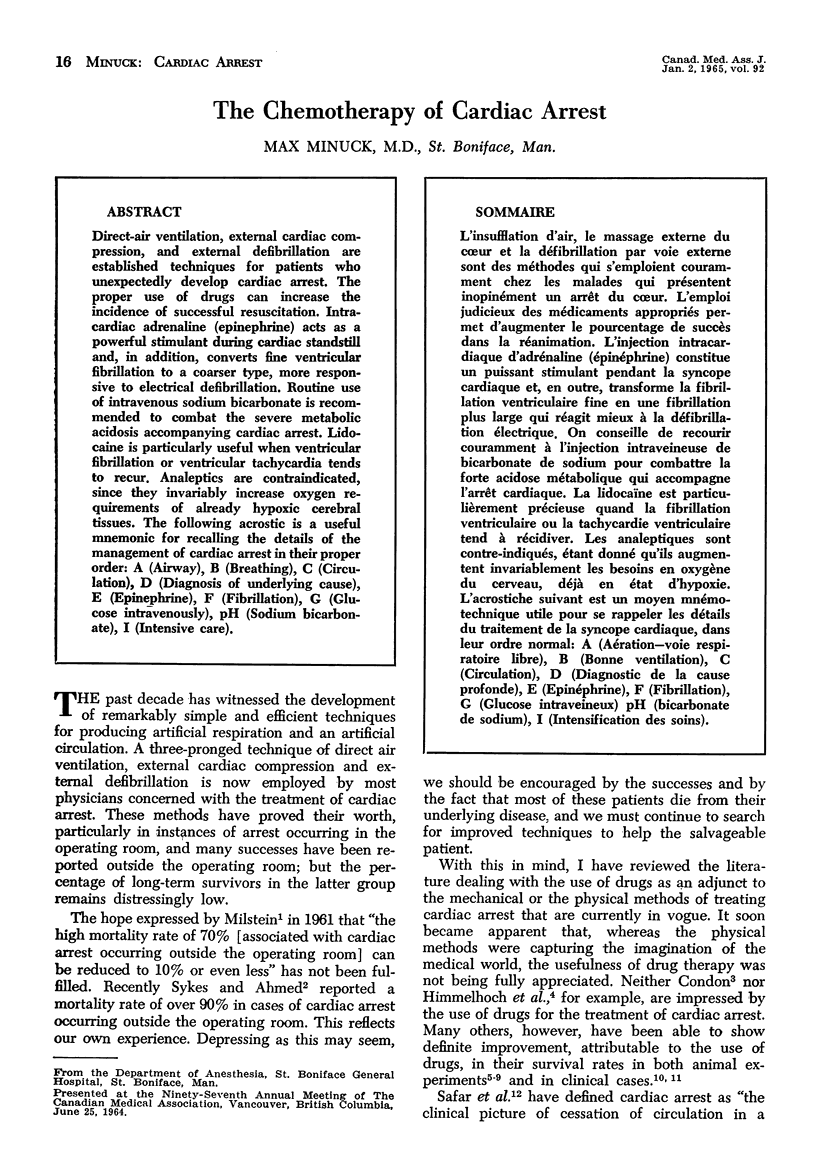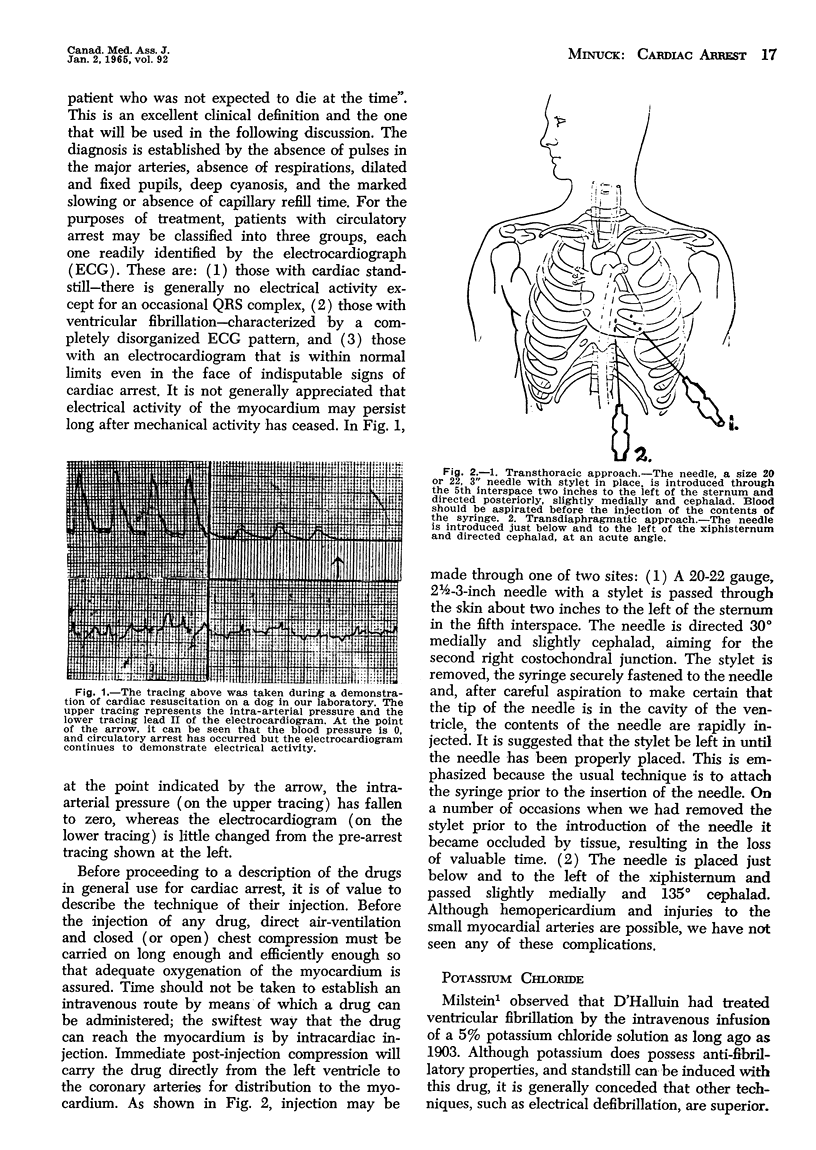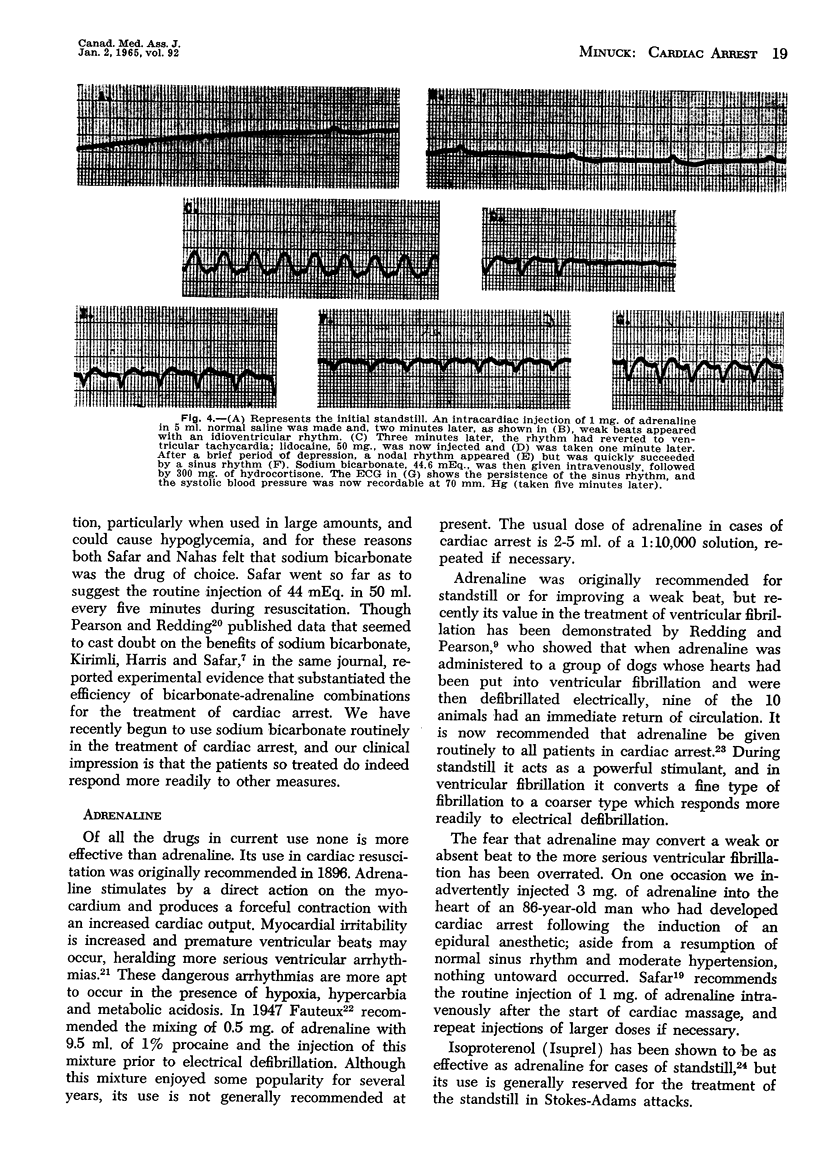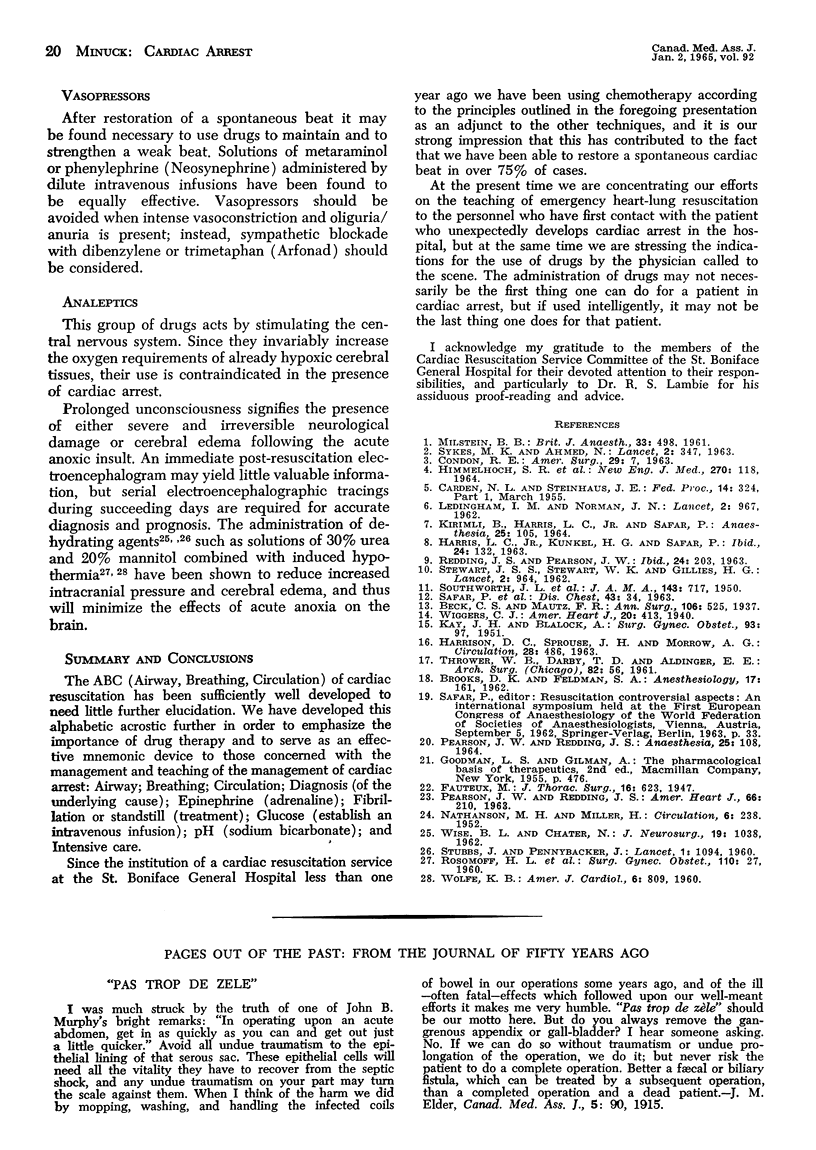Abstract
Direct-air ventilation, external cardiac compression, and external defibrillation are established techniques for patients who unexpectedly develop cardiac arrest. The proper use of drugs can increase the incidence of successful resuscitation. Intracardiac adrenaline (epinephrine) acts as a powerful stimulant during cardiac standstill and, in addition, converts fine ventricular fibrillation to a coarser type, more responsive to electrical defibrillation. Routine use of intravenous sodium bicarbonate is recommended to combat the severe metabolic acidosis accompanying cardiac arrest. Lidocaine is particularly useful when ventricular fibrillation or ventricular tachycardia tends to recur. Analeptics are contraindicated, since they invariably increase oxygen requirements of already hypoxic cerebral tissues. The following acrostic is a useful mnemonic for recalling the details of the management of cardiac arrest in their proper order: A (Airway), B (Breathing), C (Circulation), D (Diagnosis of underlying cause), E (Epinephrine), F (Fibrillation), G (Glucose intravenously), pH (Sodium bicarbonate), I (Intensive care).
Full text
PDF




Images in this article
Selected References
These references are in PubMed. This may not be the complete list of references from this article.
- BROOKS D. K., FELDMAN S. A. Metabolic acidosis. A new approach to 'neostigmine resistant curarisation'. Anaesthesia. 1962 Apr;17:161–169. doi: 10.1111/j.1365-2044.1962.tb13447.x. [DOI] [PubMed] [Google Scholar]
- Beck C. S., Mautz F. R. THE CONTROL OF THE HEART BEAT BY THE SURGEON: WITH SPECIAL REFERENCE TO VENTRICULAR FIBRILLATION OCCURRING DURING OPERATION. Ann Surg. 1937 Oct;106(4):525–537. doi: 10.1097/00000658-193710000-00004. [DOI] [PMC free article] [PubMed] [Google Scholar]
- CONDON R. E. Acute circulatory arrest: clinical experiences with fifty-one cases of cardiac arrest and massage. Am Surg. 1963 Jan;29:7–16. [PubMed] [Google Scholar]
- HARRISON D. C., SPROUSE J. H., MORROW A. G. THE ANTIARRHYTHMIC PROPERTIES OF LIDOCAINE AND PROCAINE AMIDE. CLINICAL AND PHYSIOLOGIC STUDIES OF THEIR CARDIOVASCULAR EFFECTS IN MAN. Circulation. 1963 Oct;28:486–491. doi: 10.1161/01.cir.28.4.486. [DOI] [PubMed] [Google Scholar]
- HIMMELHOCH S. R., DEKKER A., GAZZANIGA A. B., LIKE A. A. CLOSED-CHEST CARDIAC RESUSCITATION. A PROSPECTIVE CLINICAL AND PATHOLOGICAL STUDY. N Engl J Med. 1964 Jan 16;270:118–122. doi: 10.1056/NEJM196401162700302. [DOI] [PubMed] [Google Scholar]
- KAY J. H., BLALOCK A. The use of calcium chloride in the treatment of cardiac arrest in patients. Surg Gynecol Obstet. 1951 Jul;93(1):97–102. [PubMed] [Google Scholar]
- LEDINGHAM I. M., NORMAN J. N. Acid-base studies in experimental circulatory arrest. Lancet. 1962 Nov 10;2(7263):967–969. doi: 10.1016/s0140-6736(62)90730-4. [DOI] [PubMed] [Google Scholar]
- MILSTEIN B. B. Cardiac resuscitation. Br J Anaesth. 1961 Oct;33:498–515. doi: 10.1093/bja/33.10.498. [DOI] [PubMed] [Google Scholar]
- NATHANSON M. H., MILLER H. The action of norepinephrine, epinephrine and isopropyl norepinephrine on the rhythmic function of the heart. Circulation. 1952 Aug;6(2):238–244. doi: 10.1161/01.cir.6.2.238. [DOI] [PubMed] [Google Scholar]
- PEARSON J. W., REDDING J. S. EPINEPHRINE IN CARDIAC RESUSCITATION. Am Heart J. 1963 Aug;66:210–214. doi: 10.1016/0002-8703(63)90036-x. [DOI] [PubMed] [Google Scholar]
- REDDING J. S., PEARSON J. W. Evaluation of drugs for cardiac resuscitation. Anesthesiology. 1963 Mar-Apr;24:203–207. doi: 10.1097/00000542-196303000-00008. [DOI] [PubMed] [Google Scholar]
- SOUTHWORTH J. L., McKUSICK V. A., PIERCE E. C., 2nd, RAWSON F. L., Jr Ventricular fibrillation precipitated by cardiac catheterization; complete recovery of the patient after 45 minutes. J Am Med Assoc. 1950 Jun 24;143(8):717–720. doi: 10.1001/jama.1950.02910430009003. [DOI] [PubMed] [Google Scholar]
- STEWART J. S., STEWART W. K., GILLIES H. G. Cardiac arrest and acidosis. Lancet. 1962 Nov 10;2(7263):964–967. doi: 10.1016/s0140-6736(62)90729-8. [DOI] [PubMed] [Google Scholar]
- STUBBS J., PENNYBACKER J. Reduction of intracranial pressure with hypertonic urea. Lancet. 1960 May 21;1(7134):1094–1097. doi: 10.1016/s0140-6736(60)90983-1. [DOI] [PubMed] [Google Scholar]
- SYKES M. K., AHMED N. EMERGENCY TREATMENT OF CARDIAC ARREST. Lancet. 1963 Aug 17;2(7303):347–349. doi: 10.1016/s0140-6736(63)93010-1. [DOI] [PubMed] [Google Scholar]
- THROWER W. B., DARBY T. D., ALDINGER E. E. Acid-base derangements and myocardial contractility. Effects as a complication of shock. Arch Surg. 1961 Jan;82:56–65. doi: 10.1001/archsurg.1961.01300070060008. [DOI] [PubMed] [Google Scholar]
- WISE B. L., CHATER N. The value of hypertonic mannitol solution in decreasing brain mass and lowering cerebro-spinal-fluid pressure. J Neurosurg. 1962 Dec;19:1038–1043. doi: 10.3171/jns.1962.19.12.1038. [DOI] [PubMed] [Google Scholar]





